Every summer, I look forward to Obon season in Hawai‘i. Our communities gather to honor loved ones who have passed away.

Obon festivals fill the islands with lively music, traditional dances, colorful lanterns, and delicious local foods. These celebrations bring everyone together to enjoy life and heritage.
This unique mix of Japanese Buddhist traditions and island culture creates a special atmosphere.
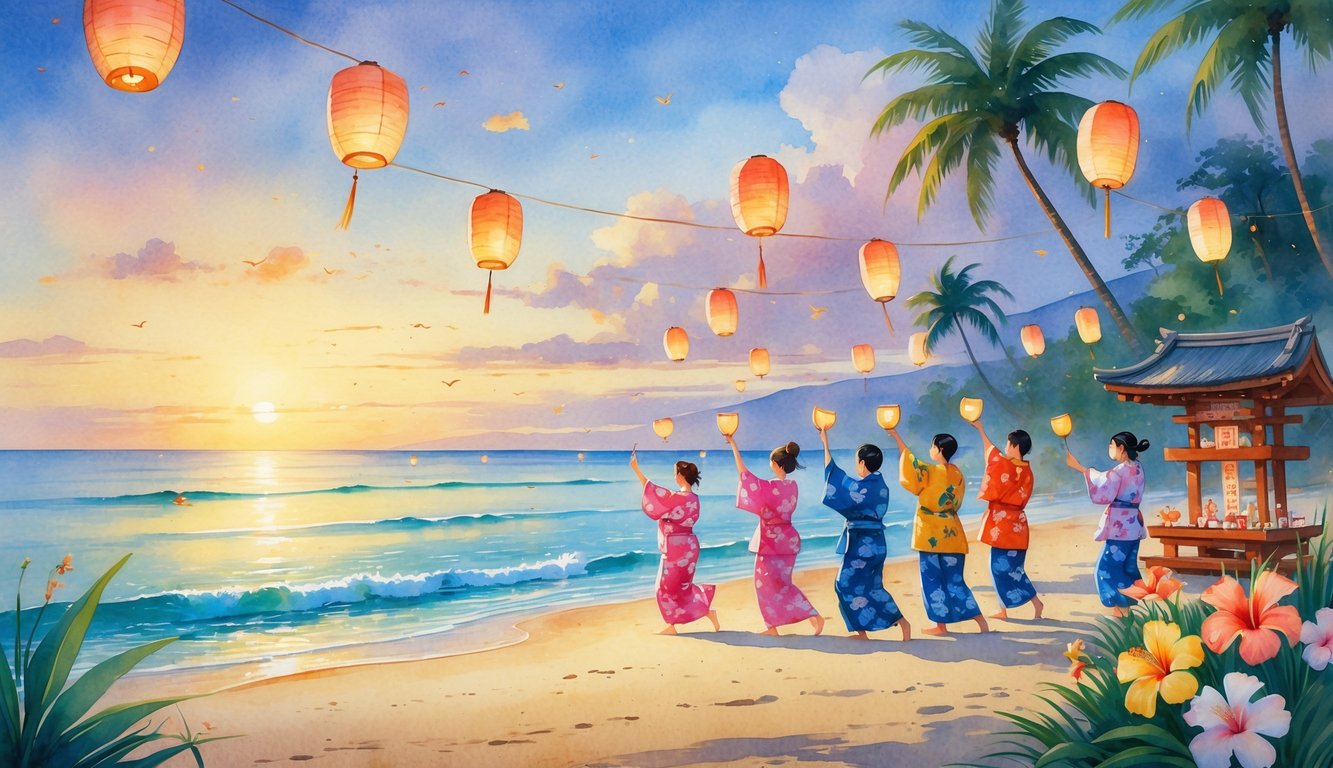
When I visit a local Obon festival, I see families gathering and friends catching up. Everyone joins in joyful bon dances that welcome the spirits of our ancestors.
From June to September, celebrations light up parks and temple grounds across the islands. These events show how much community and tradition matter here.
If you’ve ever wondered how Hawai‘i celebrates Obon or what makes these festivals memorable, you’re in the right place. I’m excited to share what makes Obon season special and how you can experience it for yourself—whether you’re a local or just visiting for the summer.
The Origins and Significance of Obon in Hawaii
Obon in Hawaii blends Japanese Buddhist beliefs with local culture. Japanese immigrants brought these traditions to Hawai‘i, and they have grown into a unique island celebration.
Obon centers around showing gratitude to ancestors. Families welcome ancestral spirits back each summer.
The Japanese Buddhist Tradition
Obon began as a Buddhist event in Japan over 500 years ago. Many people believe that the spirits of their ancestors return to visit during this time.
Every year, families clean graves, light lanterns, and join in group dances called bon odori. These traditions honor the memory of loved ones who have passed away.
In some temples, monks chant special prayers, while community members bring food as offerings. The holiday lasts several days and usually takes place during midsummer.
Obon is not only about remembering the dead. It is also about showing appreciation for their sacrifices.
Ancestral Spirits and Gratitude
During Obon, families focus on welcoming the spirits of deceased relatives. At home, families set up small tables called butsudan with flowers, incense, and favorite foods to show thanks.
Some families hang lanterns to help guide the spirits back. The purpose is to express deep gratitude for what ancestors have given us—our lives, traditions, and community.
Dances like bon odori celebrate the connection between the living and the dead. People believe that by showing respect and thankfulness, they keep family bonds strong even after death.
Role of Japanese Immigrants
Japanese immigrants brought Obon to Hawaii in the late 1800s. Plantation workers carried their Buddhist beliefs and Obon customs to the islands.
They used this tradition to stay close to their roots and support each other far from home. Over time, Obon in Hawaii changed as people from different backgrounds joined the celebration.
Festivals now include a mix of Japanese and local traditions. Obon has become popular with many groups.
Obon’s roots show how Japanese immigrants used their faith to build a sense of belonging and community.
Key Customs and Rituals of Obon
During Obon in Hawaii, I take part in special practices that connect me to my ancestors. Each tradition holds deep meaning, from dancing in memory of loved ones to lighting lanterns to guide spirits.
Bon Odori and Community Dance
Bon Odori, also known as the bon dance, is one of my favorite traditions during Obon. I join people of all ages in lively circle dances at local temples.
The dances use simple, repeated movements, making it easy for newcomers to join in. The music for Bon Odori includes taiko drums and traditional folk songs.
Dancers often wear light cotton yukata, but everyday clothes are welcome too. These dances let me show gratitude and joy while honoring the sacrifices of ancestors.
In Hawaii, Obon festivals offer a chance to reconnect and celebrate with family and friends. Food booths, games, and local treats make it a true community gathering.
Learn more about the bon dance tradition in Hawaii.
Offerings and Memorial Traditions
During Obon, I help prepare special offerings for my ancestors. Families visit graves, clean the area, and bring flowers, incense, and food that loved ones enjoyed.
We place these offerings at home altars, called butsudan, as well as at gravesites. Lighting incense and bowing in prayer are important steps in the ritual.
These quiet moments help me remember and thank the people who came before me. In Hawaii, each household may have unique customs.
Some join larger temple ceremonies, while others hold small gatherings at home. The gesture of giving remains the same—a sign of honor for ancestral spirits during Obon.
Details on these Obon memorial traditions help me understand their importance.
Lantern Lighting and Toro Nagashi
One of the most beautiful parts of Obon for me is lantern lighting and toro nagashi. Families and temple groups light paper lanterns, called toro, in memory of the departed.
The glowing lights gently honor and guide ancestral spirits back to the world beyond after their visit. The tradition of toro nagashi involves floating lanterns down rivers or onto the ocean at the close of Obon.
Watching the lanterns drift away is peaceful and moving. It symbolizes letting go, sharing prayers, and marking the end of the celebration.
Lantern festivals in Hawaii often draw large crowds. I join others in writing messages or names on the lanterns before setting them afloat.
Hatsubon: Honoring First-Year Memorials
Hatsubon is the first Obon held after someone in the family has passed away. It’s a deeply emotional event for me and others who are experiencing it for the first time.
Families gather for hatsubon and participate in temple services with prayers and more elaborate offerings. There may be a special spot or lantern for the newly departed, so their spirit is warmly welcomed and remembered.
Friends and family provide support by visiting and sharing memories. Hatsubon gives everyone a chance to grieve together and celebrate the life of the loved one.
The meaning behind hatsubon practices reminds me of the importance of remembrance in Obon celebrations.
Bon Dance: Heart of Obon Festivities
When I visit Hawaii during Obon season, bon dances stand out the most. These events bring together families, friends, and neighbors through music, dance, and food.
The energy, tradition, and community spirit at these dance festivals are unforgettable.
Traditional Dances and Yagura
At the center of every bon dance, I see the yagura, a high wooden tower. Musicians and singers perform here, guiding everyone with the rhythm of the music.
Dancers move in circles around the yagura, following steps passed down for generations. Bon dancing is easy to join.
Steps are repetitive and simple, so both young and old can take part. Many wear yukata (summer kimonos) or happi coats, adding to the traditional atmosphere.
Dance styles can differ from one festival to another. Some dances reflect the local community or honor certain ancestors.
It’s a joyful way for everyone to remember loved ones and experience a living tradition. More about the cultural impact of these Obon dance festivals in Hawaii can be found online.
Taiko Drumming and Music
The heartbeat of every bon dance, in my experience, comes from the deep sounds of taiko drums. Taiko drummers play with passion, using large sticks to pound rhythms that echo through the night.
Their music sets the pace for each dance, and the beats seem to pull everyone to the dance circle. Taiko drumming is not just background music—it’s a performance.
Drummers move with energy and skill, making it exciting to watch. Sometimes there are other traditional instruments, like flutes or shamisen, but taiko is always the star.
Live music connects everyone. Listening to taiko drums helps me feel the shared purpose of the event and the respect for ancestors.
Eisa and Okinawan Culture
One of my favorite parts of Oahu’s bon dance scene is the presence of Eisa. Eisa is a special style of dance and drumming from Okinawa.
Unlike the slower motions of other Obon dances, Eisa is fast and lively, with strong arm movements and unique rhythms. Eisa groups wear colorful costumes that set them apart.
They often use smaller drums strapped to their bodies. This lets them move freely and create different sounds.
The dance tells stories from Okinawan history and encourages younger generations to stay connected to their roots. When I see Eisa performed, I’m reminded how Hawaii’s Obon celebrations honor many cultures.
Okinawan music, dance, and spirit are a vibrant part of the festival. For more information on Eisa and its role in Obon, check out this feature on Okinawan culture and dance in Hawaii.
Cultural Attire and Festival Wear
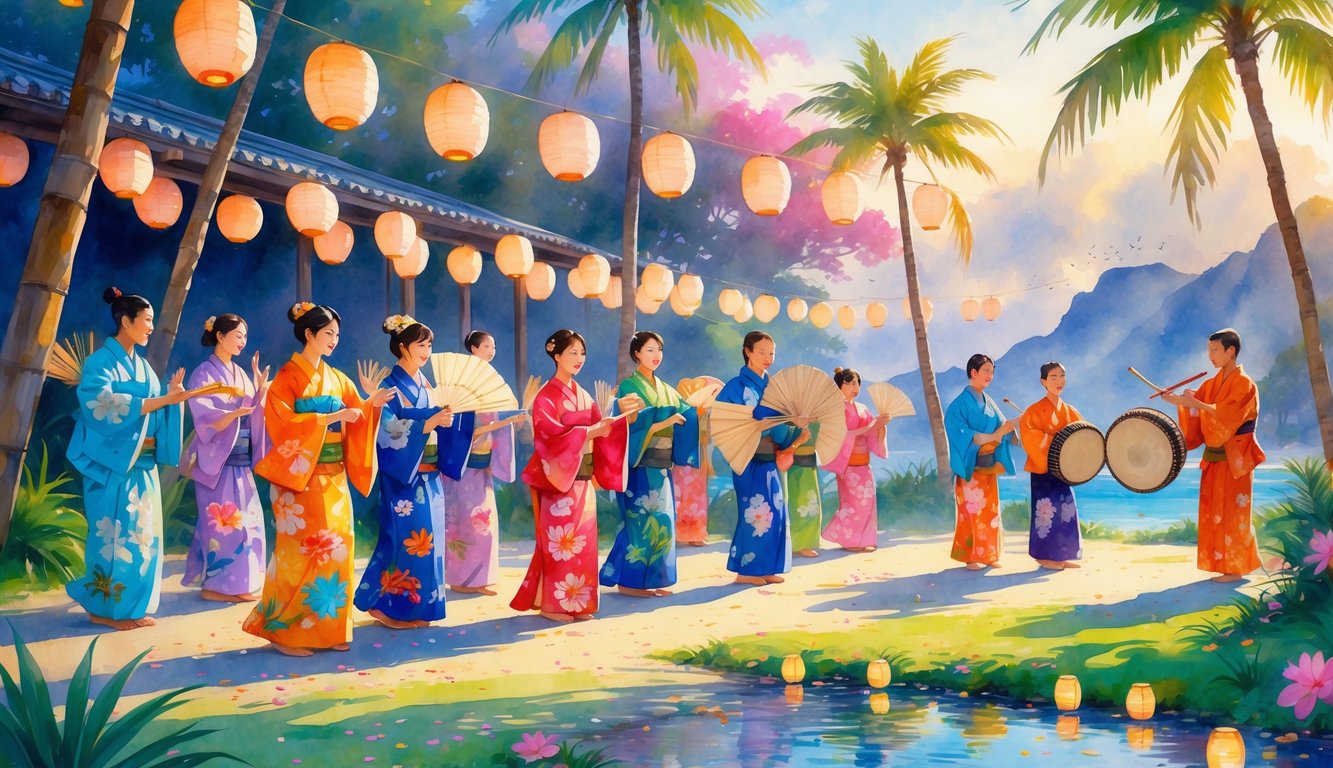
When I go to Obon festivals in Hawaii, traditional clothing adds a colorful and meaningful touch to the celebration. Wearing these outfits shows respect for the event and helps me feel connected to both Japanese heritage and the local community.
Kimono, Yukata, and Summer Kimono
A kimono is a classic Japanese robe with wide sleeves and a sash called an obi. People make it from silk or cotton.
At Obon, I often see people wear lighter versions because of Hawaii’s warm weather. A summer kimono, or yukata, uses cotton and feels more comfortable for dancing or walking around.
Yukata have bright patterns and allow easy movement, making them perfect for outdoor festivals. I see friends and families dress in matching colors, which makes group dances special.
The obi belt is simple to tie and doesn’t feel heavy or tight. I wear sandals called zori with my yukata to complete the look.
Men’s yukata use darker shades or simple stripes, while women’s are more colorful. Both styles are easy to put on, so I never worry about getting ready.
This traditional clothing brings a sense of unity and joy as I join in Bon Odori, the folk dance during Obon. For more details on how people in Hawaii dress for these festivals, I use guides from Buddhist temples.
Happi Coats and Yukata Kimonos
A happi coat is a short festival jacket, usually made from cotton, with family crests or bold designs. When I want something simple and comfortable, I choose a happi coat.
These jackets are easy to slip on and pair well with jeans, shorts, or a yukata. Sometimes, entire dance groups wear matching happi coats to show they are part of the same team.
The short length keeps me cool and lets me move my arms freely while dancing. Both kids and adults wear them, so my whole family joins in.
Happi coats are usually tied with a thin belt and can be worn open or closed. The bright designs make me feel festive, and I like how easy it is to switch between a happi coat and a full yukata kimono during Obon.
Obon Festival Foods and Treats
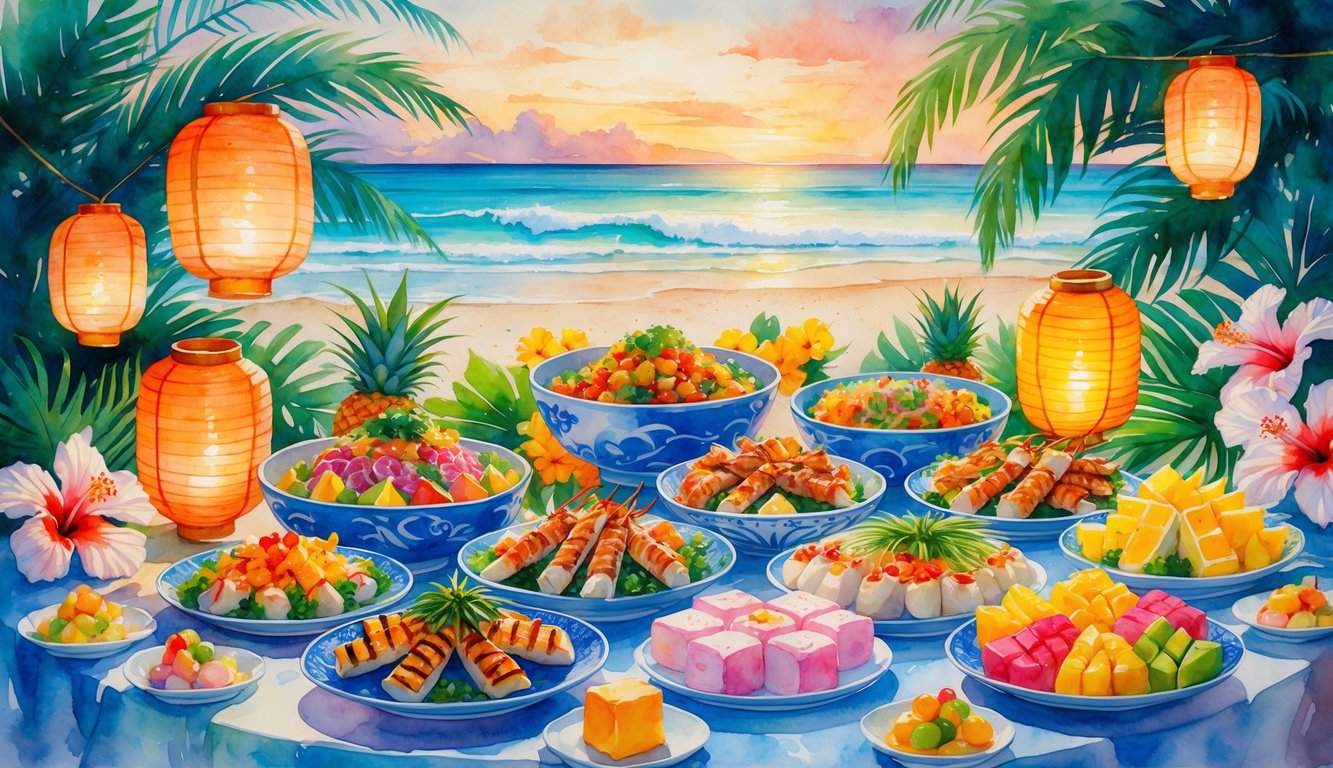
Every year, I look forward to the food at Hawaii’s Obon festivals. I get to taste both Japanese favorites and local treats, all in one place.
These meals and snacks bring people together and are a big part of the celebration.
Japanese Food and Festival Specialties
At Obon festivals, I often find classic Japanese dishes that remind me of tradition. Stalls serve fresh yakisoba (fried noodles), loaded with veggies, meat, and sweet-savory sauce.
Takoyaki, bite-sized balls filled with tender octopus and topped with bonito flakes, are another popular snack. Inarizushi, sweetened tofu pouches stuffed with rice, are simple, delicious, and easy to eat on the go.
Hamburger curry appears at many booths, blending local flavors with Japanese curry. I also see people sharing bowls of miso soup, plates of tempura, and piles of freshly cooked rice balls.
If you want to see a full list of dishes served at each temple, Honolulu Magazine has a helpful guide with festival foods like hamburger curry, fried noodles, and more.
Andagi and Other Local Favorites
One treat I never skip is andagi, a sweet Okinawan doughnut. It’s round and golden-brown, with a crisp outside and soft inside.
Sometimes, the line for andagi is the longest at the festival. Besides andagi, KC Waffle Dogs are often available, which are hot dogs wrapped in waffle batter and fried until crispy.
Spam musubi, chicken katsu, and shave ice show the local Hawaii twist on festival food. Some booths serve butter mochi and manju, making it a fun place to try new treats.
The mix of Japanese and local Hawaiian snacks means there’s something tasty for everyone.
Food Booths and Community Meals
Most Obon festivals have rows of food booths run by community volunteers. I like walking from booth to booth, getting a little of everything.
These stands raise money for local temples and help everyone feel included. Some booths sell tickets for set meals packed with rice, tsukemono (pickled veggies), teriyaki chicken, and sides.
Many people eat together at picnic tables under tents while watching the dancing. The act of sharing food, cooking, and eating with others feels like the heart of the festival to me.
For more details on what to expect at the food booths, you can check out this ultimate guide to Obon festival foods on Oahu.
Major Obon Events and Venues Across Hawai‘i
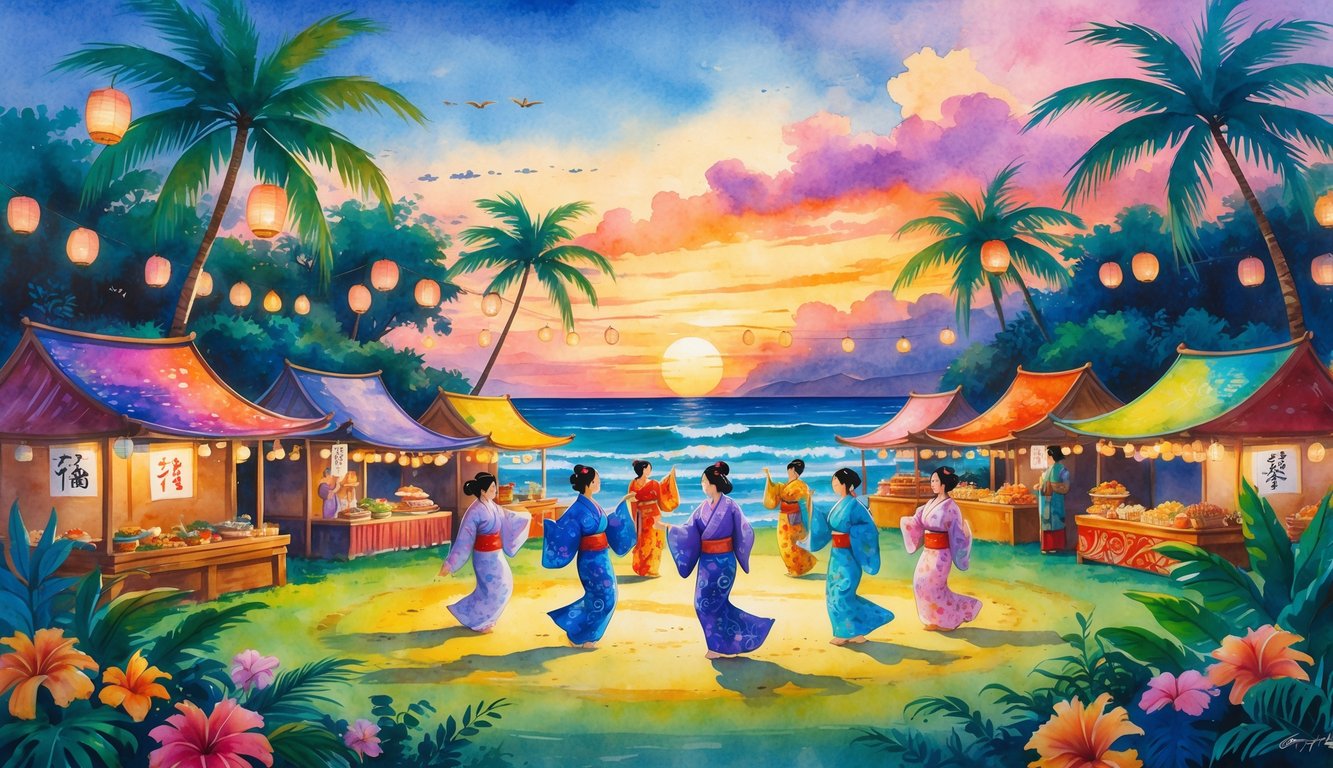
Obon festivals in Hawai‘i bring communities together to remember loved ones, learn about Japanese culture, and enjoy dancing and food. These events happen at temples, parks, and gathering places across the islands.
Honpa Hongwanji Hawaii Betsuin and Prominent Temples
The Honpa Hongwanji Hawaii Betsuin stands out as one of the most significant venues for Obon season on Oʻahu. Every summer, this well-known Buddhist temple hosts lively Bon Dances and rituals that draw big crowds from Honolulu and beyond.
When I visit Honpa Hongwanji, I see families, volunteers, and monks working together to set up lantern displays and food booths. The temple grounds fill with music, taiko drums, and voices singing Bon Odori songs.
Many people wear yukata and join the circular dances, honoring ancestors and celebrating together. Other important Buddhist temples, like Moiliili Hongwanji and Pearl City Hongwanji, also organize their own Obon festivals.
Each temple adds unique touches, such as home-cooked meals, craft stands, and kids’ games. Temples welcome everyone, whether you’re a temple member or a visitor, making it easy to take part in these cherished Obon traditions.
Obon Celebrations on Oʻahu and Neighbor Islands
Oʻahu has the largest number of Obon events, but every island marks the season with its own festivals. At venues across Oʻahu, like Koganji Temple and Jodo Mission of Hawaii, I find weekly Bon Dances from June through September.
On Maui, the Maui Hongwanji Mission holds vibrant celebrations too. Some neighbor islands add local twists.
On Kaua‘i, Soto Zen temples mix Obon traditions with Hawaiian music. The Big Island hosts events at Buddhist temples in both Hilo and Kona.
The variety of locations lets me join dances in many neighborhoods. I always meet new people and try fresh festival food.
A schedule of Obon events across Oʻahu and the islands helps locals and visitors plan their summer.
Megabon and Large Community Gatherings
Some venues organize Megabon—extra-large events that bring together multiple temples, clubs, and the wider public. These gatherings, often held in big parks or temple parking lots, can draw thousands.
At Megabon, I see long lines for okonomiyaki and shave ice. Community groups give taiko performances and martial arts demos.
There’s often a large dance circle under paper lanterns, open for everyone to join. Food stands, craft booths, and children’s activities line the area.
These festivals feel like block parties and cultural fairs combined. It’s easy for anyone, even first-timers, to feel welcome and be part of the celebration.
Find out when Megabon and large Obon events are happening with this guide to Obon festivals on Oʻahu.
Participating Temples and Community Organizations
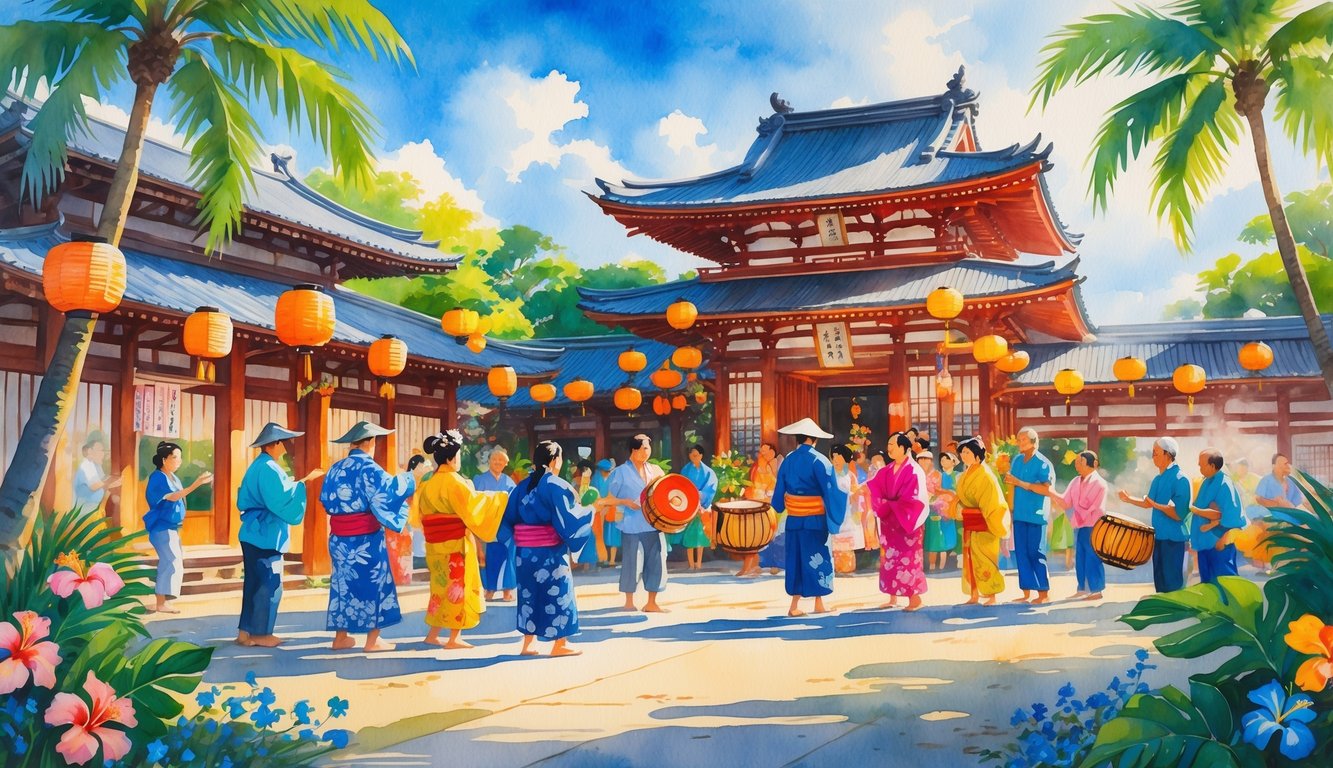
Obon celebrations in Hawaii bring together many Buddhist temples and community groups. These organizations each offer unique events, dances, and service projects that are open to everyone.
Hongwanji and Soto Zen Missions
The Hongwanji and Soto Zen temples play a big role during Obon season. These temples include Aiea Hongwanji, Wahiawa Hongwanji Mission, Jikoen Hongwanji, Palolo Hongwanji, Shinshu Kyokai Mission, Waipahu Hongwanji Buddhist Temple, and Mililani Hongwanji.
They host bon dances, memorial services, and food booths. Many also schedule taiko drum performances and lantern ceremonies honoring loved ones.
The Soto Zen missions—like Waipahu Soto Zen Temple, Soto Mission of Hawaii, Waipahu Soto Zen Temple Taiyoji, Guzeiji Soto Mission, and Hilo Taishoji Soto Mission—add their own traditions. At each spot, I see colorful yukata, paper lanterns, and families dancing together.
Dates and times can vary, so I always check the current festival schedule. These events are open to all, and everyone is welcome to join.
Jodo and Shingon Missions
The Jodo and Shingon missions in Hawaii also have a strong presence during Obon. Temples like Jodo Mission of Hawaii, Haleiwa Jodo Mission, and Koboji Shingon Mission hold events that keep age-old customs alive for the community.
At Jodo temples, I enjoy lantern floating and Buddhist chanting. Shingon missions—including Shingon Mission of Hawaii and Haleiwa Shingon Mission—feature traditional rituals and lively bon dances in the temple courtyard.
Volunteers help set up lantern displays, food stalls, and seasonal decorations. People of all backgrounds attend, and visitors are invited to participate in prayers and festivities.
These temples make room for everyone, welcoming both locals and tourists.
Rissho Kosei-kai Buddhist Church
Rissho Kosei-kai and the Rissho Kosei-kai Buddhist Church of Hawaii take part in Obon all summer. Their events include humanistic Buddhist practices, bon dances, and memorial services.
This group focuses on community outreach, sharing teachings about compassion, respect for ancestors, and world peace. Services honor the departed through song, prayer, and flower offerings.
Families gather in and outside the church. I see cultural performances and hear messages that support kindness and unity.
The mood here is always warm and welcoming, making it a favorite stop during Obon.
If I want to learn about Buddhism’s modern teachings and meet people from many walks of life, this is the place I go.
Community Support and Volunteerism
Community support keeps Obon strong in Hawaii. Volunteers from youth groups, local businesses, and neighborhood clubs help with all kinds of festival jobs.
They organize setup and cleanup, run food stands, and guide dance circles. Groups offer service projects, donation drives, and language help for visitors.
Some even host activities for seniors and children to make everyone feel included. Temples work closely with schools and civic organizations.
This teamwork allows events like the Obon festivals and bon dances to be safe, friendly, and fun.
Family Traditions and Symbolic Offerings
Each summer, I look forward to the unique customs that make Obon so special in Hawaii. Families gather to prepare meaningful displays and rituals that help us honor loved ones and invite ancestral spirits home.
Cucumber Horses and Eggplant Cows
One of my favorite parts is crafting shōryō-uma, or spirit animals, from cucumbers and eggplants.
I use chopsticks or bamboo sticks to make legs for the vegetables.
The cucumber often becomes a “spirit horse.” The eggplant turns into a “spirit cow.”
The cucumber horse shows our wish for ancestors to return quickly, since horses are fast.
The eggplant cow is slower and helps ancestors make a calm, gentle journey back after Obon.
Families place these creations near the altar or entrance to guide spirits to and from our homes.
Making these offerings helps me feel connected to my heritage.
It reminds me of the importance of hospitality during this season.
Paper Lanterns and Symbolism
Paper lanterns, called chōchin or tōrō, are another important part of Obon traditions.
I love seeing the soft, warm glow of colorful lanterns hanging outside homes, temples, and around grave sites during festivals.
These lanterns are not just decorations.
They gently guide the spirits and help them find their way back home.
Some families, including mine, also float lanterns on water to guide spirits safely as Obon ends.
We often light incense and place food or flowers on the altar along with the lanterns.
The glowing lights and familiar scents make Obon a time of remembrance and reunion.
Learn more about these traditions at the Japanese Cultural Center of Hawaii.
Contemporary Celebrations and Community Spirit
In Hawaii, Obon season continues as a living tradition.
Neighbors, friends, and families come together each summer.
The celebrations have changed over time but still connect to customs, music, and the community’s colorful heart.
Modern Adaptations of Obon
When I go to Obon festivals in Hawaii, I see old and new traditions come together.
Many events keep the bon dance at the center.
You’ll also find local food booths, charity sales, and craft vendors.
These changes make the festival both familiar and fresh each year.
Some temples float lanterns on water for tōrō nagashi to honor loved ones who have passed.
Digital promotions and social media invites help spread the word and bring bigger crowds.
In recent summers, I have seen live-streamed events for those who can’t attend in person.
People of all ages join the circle to dance, wearing yukata or aloha shirts.
New songs sometimes mix with traditional tunes.
Every beat and step celebrates ancestors and brings everyone together.
You can read more about these modern Obon celebrations on Oahu.
Connecting Generations and Local Identity
One of the most touching parts of Obon is how it connects generations.
Grandparents teach children the steps to the bon odori and tell stories about family traditions as we move around the yagura tower.
For some families, hatsubon—the first memorial service after a loved one passes—adds special meaning to the season.
Obon isn’t just for people of Japanese descent.
In Hawaii, people from all backgrounds join the celebrations.
This helps the tradition feel like a true part of local culture.
Customs from centuries ago mix with the Hawaiian spirit of aloha to create lasting memories.
Bon dances run all summer and help keep our community close knit, as explained in this guide to Obon festivals on Oahu.
Okinawan Festival and Hawaiian Influences
The Okinawan Festival in Hawaii is another highlight of the season for me.
While it relates to Obon, it brings its own energy with unique dances like the eisa, music with sanshin (three-stringed instruments), and colorful traditional costumes.
Local favorites like andagi (Okinawan donuts) fill the food stalls.
I always look forward to the mix of flavors.
This festival welcomes everyone.
Hawaiian and Okinawan traditions blend together, like taiko drumming with hula performances.
Events like these help keep the spirit of Obon and Okinawan culture strong in Hawaii.
People gather from across the islands to celebrate, eat, and enjoy cultural shows.
The Okinawan Festival has become a summer highlight for Hawai‘i families.
Conclusion
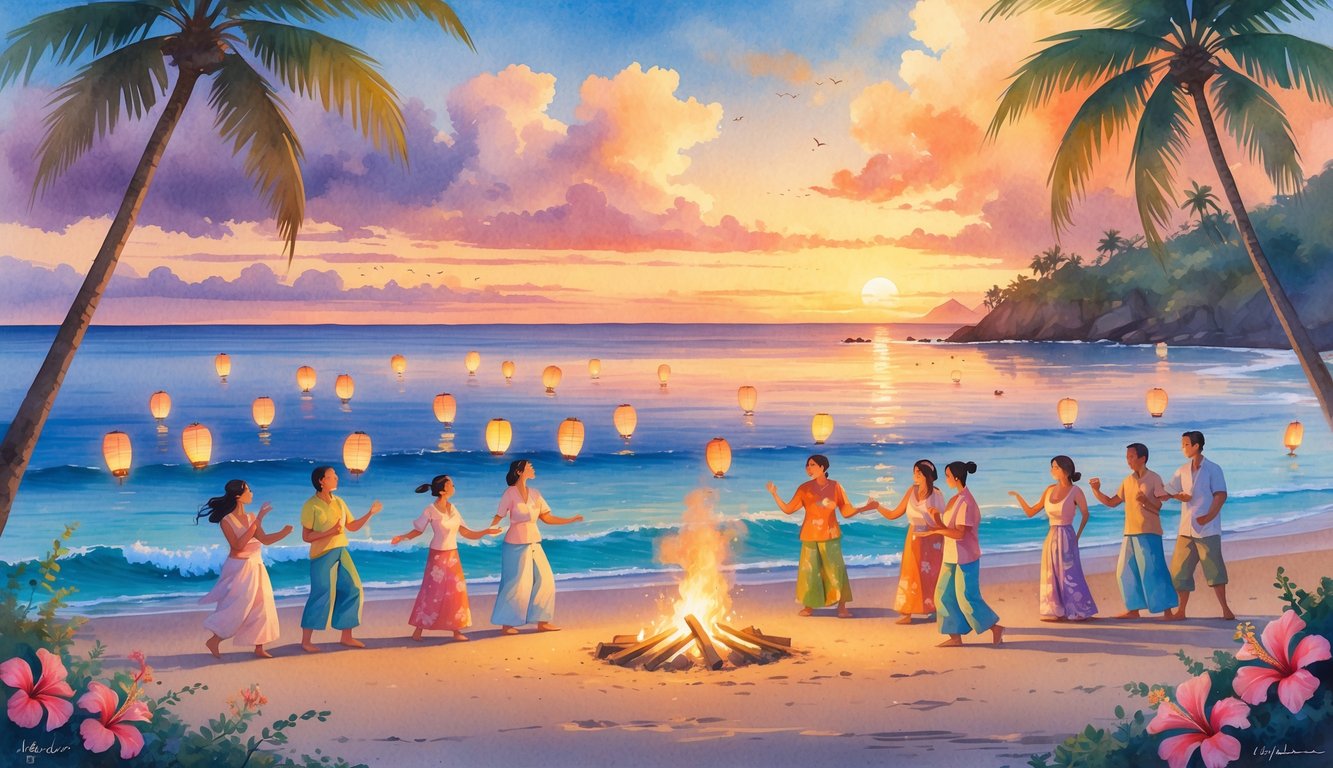
When I think about Obon season in Hawai‘i, I feel a deep sense of gratitude. The traditions bring people together, no matter their background or beliefs.
Every summer, families gather to remember ancestors and thank them for their sacrifices. I love seeing how the community shows respect through bon dance, music, and special foods.
Obon welcomes everyone in Hawai‘i, not just Japanese families. Friends and neighbors from many cultures join the celebration.
This helps keep the spirit of aloha strong. You can read more about how the Obon festival brings communities together in Hawai‘i.
Here’s what stands out to me about Obon in Hawai‘i:
| Tradition | Meaning |
|---|---|
| Bon Odori Dance | Honors ancestors and shares joy |
| Memorial Services | Gives thanks and remembers loved ones |
| Lantern Lighting | Symbolizes guiding spirits home |
For me, Obon is a time to pause and be thankful. I enjoy the dancing, but I appreciate the feelings of connection and community that last after the music stops.




